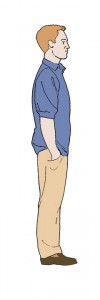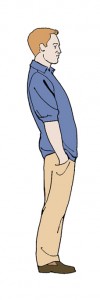 Standing and walking with ease allows the body to minimize the muscular forces working
Standing and walking with ease allows the body to minimize the muscular forces working to hold us up. Walking can be an effortless event carried along by the force of gravity. As we learn to live in this place of ease on a regular basis, ease in the body can become a constant in our lives. Instead most of us live in a body where the muscles are asked to do way more than necessary. See for yourself.
to hold us up. Walking can be an effortless event carried along by the force of gravity. As we learn to live in this place of ease on a regular basis, ease in the body can become a constant in our lives. Instead most of us live in a body where the muscles are asked to do way more than necessary. See for yourself.
Stand up with your feet about four inches apart and pay attention to how you hold yourself in space. Where is the weight in your feet? What are your calves doing? Are your thighs falling forward of your ankles or are your legs situated underneath your pelvis? Keep working your way up the body. Is your pelvis tucked under or stuck out?
Try to imagine the base of your ribcage and feel if it is level with both the floor and the pelvis. Last but so far from least, is your head positioned directly over your shoulders? Standing and walking with ease requires the body to be lined up with the ears, shoulders, hips, knees, and ankles in one straight line perpendicular to the floor.
Most people have fallen out of alignment in similar ways. See if the following picture resonates with you. The calves sink backward taking the weight of the feet into the heels. The backward movement of the calves is counteracted by a forward thrust of the femur (thigh) bones, which drag the pelvis forward and down at the back. This action arches the lower back and drags down the middle back which is one of the factors creating the tilting ribcage. The upper back pulls backwards to counter the lower back moving forward and finally the head begins its journey forward because nothing in the spine is providing any support for the neck. None of these factors leads us towards standing and walking with ease.
This might not be you exactly but the odds are if you look around as you walk down the street you will find many that fit the bill and with honest analysis you might find that you are not what you think you are in terms of posture and movement. Depending upon what you see and feel, it is not hard to start to change. Awareness is the beginning of a body’s renaissance. Simply begin to pay attention to how you stand and how you walk. You want to begin to play with the feeling of getting the bottom half of the body underneath the top half trying to stack your bones in an efficient line. If you can do this, muscles will begin to relax and standing becomes easier.
Here’s one way to begin to find this alignment. Start with the pelvis. We think almost everyone tucks their pelvis under creating a negative pull on the lower back.
Standing, bring your femur (thigh) bones directly beneath the pelvis by tilting the top of your pelvis forward slightly letting the leg bones move underneath your hips. This should release your buttocks and allow your quadriceps muscles (thigh) to take a little less of the load, though it might not feel that way. When you take the legs to a new position under the pelvis these quad muscles sometimes freak out simply from working differently. Trying to find a new arrangement of the pelvis is a simple and very valuable first step to new posture. Feel what untucking the pelvis does to the surrounding structures—the lower back, the inner and outer thighs and everything else in the pelvic area. This is an easy way to begin your adventure in standing and walking with ease.
